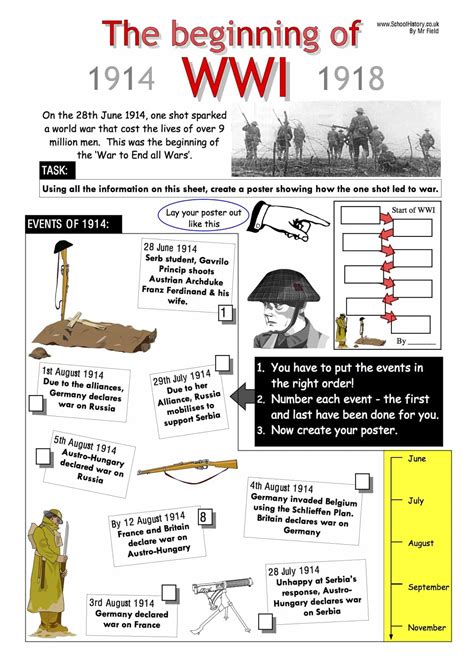Introduction

World War I, also known as the Great War, was a global conflict that lasted from 1914 to 1918. It involved all the great powers of the time and had a profound impact on the course of world history.
This World War 1 test will assess your knowledge of this pivotal event. Test your understanding of the causes, major battles, key figures, and long-term consequences of the war.
Causes of World War I
1. Imperialism and Nationalism
- European powers competed for colonies and resources, leading to tensions and rivalries.
- Nationalism fueled a sense of national pride and ambition, particularly in Germany and Austria-Hungary.
2. Militarism
- European countries engaged in a military buildup, believing that a strong military was essential for national security.
- Germany’s Schlieffen Plan outlined a rapid mobilization and invasion of France in the event of war.
3. Alliances and Miscalculations
- The Triple Alliance (Germany, Austria-Hungary, Italy) and the Triple Entente (France, Russia, Britain) created a web of alliances that obligated nations to come to the aid of their allies in the event of conflict.
- Diplomatic miscalculations and misunderstandings further escalated tensions.
4. The Spark: Assassination of Archduke Franz Ferdinand
- On June 28, 1914, Archduke Franz Ferdinand, heir to the Austro-Hungarian throne, was assassinated in Sarajevo, Bosnia.
- Austria-Hungary blamed Serbia for the assassination and declared war, setting off a chain reaction of alliances and declarations of war.
Major Battles
1. Battle of the Marne (September 5-12, 1914)
- France stopped the German advance towards Paris, marking a turning point in the war.
2. Battle of the Somme (July 1-November 18, 1916)
- One of the bloodiest battles in history, with over 1 million casualties.
- British and French forces failed to break through German lines.
3. Battle of Verdun (February 21-December 18, 1916)
- German offensive on the French fortress of Verdun.
- Estimated 700,000 casualties on both sides.
4. Battle of Passchendaele (July 31-November 10, 1917)
- British offensive in Belgium.
- Heavy casualties and minimal gains.
5. Battle of Amiens (August 8-11, 1918)
- Allied counteroffensive that began the final push to victory.
Key Figures
1. Kaiser Wilhelm II
- German emperor.
- Aggressive and expansionist policies contributed to the outbreak of war.
2. Franz Joseph I
- Emperor of Austria-Hungary.
- Conservative and indecisive.
3. Nicholas II
- Tsar of Russia.
- Autocratic and unprepared for the demands of modern warfare.
4. David Lloyd George
- British prime minister.
- Advocated for a decisive victory.
5. Georges Clemenceau
- French prime minister.
- Unwavering in his determination to defeat Germany.
Long-Term Consequences
1. Human Toll
- Estimated 17 million military and civilian deaths.
- Millions more wounded or displaced.
2. Political Changes
- Collapse of the Ottoman, Russian, Austro-Hungarian, and German empires.
- Rise of new nation-states, such as Yugoslavia and Czechoslovakia.
3. Economic Crisis
- Wartime spending led to massive debt and inflation.
- Global economic depression followed the war.
4. Social Changes
- Women gained new roles in the workforce and society.
- Increased demand for democratic reforms.
5. Treaty of Versailles
- Peace treaty signed in 1919.
- Punitive provisions against Germany, including reparations and territorial losses.
- Many historians believe the treaty sowed the seeds for World War II.
Test Questions
1. What was the primary cause of World War I?
A. Imperialism
B. Nationalism
C. Militarism
D. All of the above
2. Which of the following was NOT a member of the Triple Entente?
A. France
B. Russia
C. Britain
D. Germany
3. Who was the emperor of Germany during World War I?
A. Franz Joseph I
B. Nicholas II
C. Kaiser Wilhelm II
D. Georges Clemenceau
4. Which battle marked the beginning of the final push to Allied victory in World War I?
A. Battle of the Marne
B. Battle of the Somme
C. Battle of Verdun
D. Battle of Amiens
5. What was the estimated death toll of World War I?
A. 10 million
B. 15 million
C. 17 million
D. 20 million
6. Which of the following was a long-term consequence of World War I?
A. Collapse of the Austro-Hungarian Empire
B. Rise of the United States as a global superpower
C. Economic depression
D. Both A and C
Answers
- D
- D
- C
- D
- C
- D
Conclusion
World War I was a defining moment in world history. Its causes, battles, and consequences have shaped the modern world. This test has provided you with an opportunity to assess your knowledge of the Great War.
To further enhance your understanding, we encourage you to explore additional resources, such as books, documentaries, and historical websites. By delving deeper into this pivotal event, you will gain a deeper appreciation for its complexities and the profound impact it had on the 20th century and beyond.
